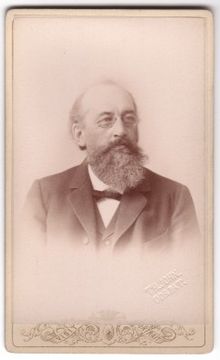Edmund Russow
Edmund Russow | |
|---|---|
 | |
| Born | 24 February 1841 |
| Died | 11 April 1897 (aged 56) |
| Nationality | Baltic German |
| Citizenship | Russian |
| Scientific career | |
| Institutions | University of Tartu |
Edmund August Friedrich Russow (24 February 1841 – 11 April 1897) was a Baltic German biologist born in Tallinn (German: Reval), in present-day Estonia.
Academic career
Son of a military engineer, Edmund Russow studied at the Universities of Tartu (German: Dorpat) and Berlin. In 1867 he became an associate professor at Dorpat, where from 1874 to 1897, he served as a full professor. In 1895-97 he was president of the Estonian Naturalists' Society. Russow was at the forefront of nature conservation in Estonia, and associated with the work of Hugo Conwentz (1865-1922), a founder of nature conservation efforts throughout Europe.
Botanical work
Russow was an authority on Sphagnaceae (sphagnum mosses)[1] and remembered for his research in plant anatomy and histology, in particular studies of the plant family Marsileaceae (aquatic and semi-aquatic ferns).[2] The plant genus Russowia is named in his honor,[3] as is Sphagnum russowii (Russow's sphagnum).
Written works
- Histologie und Entwicklungsgeschichte der Sporenfrucht von Marsilia. Dissertation. Dorpat (1871)
- Entwickelungsgeschichte der Sporenfrucht von Marsilia (1873). In: Mémoires de l'Académie Impériale des Sciences de Saint-Pétersbourg, série VII, tome XIX, p. 42
- Vergleichende Untersuchungen betreffend die Histiologie … der leitbundel Kryptogamen. In: Mémoires de l'Académie Impériale des Sciences de St.-Pétersbourg, 1872
- Betrachtungen über das leitbundel- und grundgewebe aus vergleichend morphologischem und phylogenetischem geschichtspunkt (1875).[4]
References
- "Biographical information based on an equivalent article at the Estonian Wikipedia".
